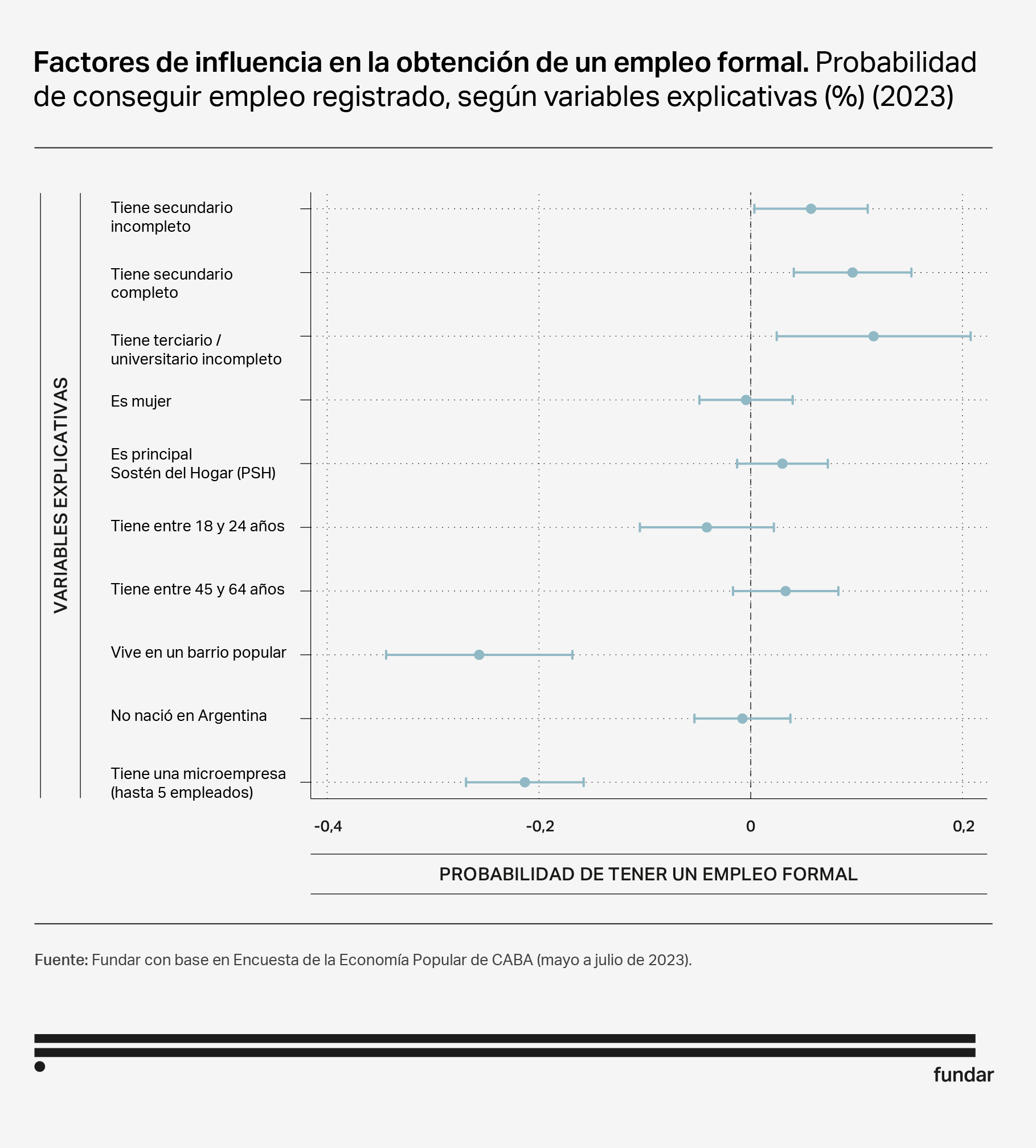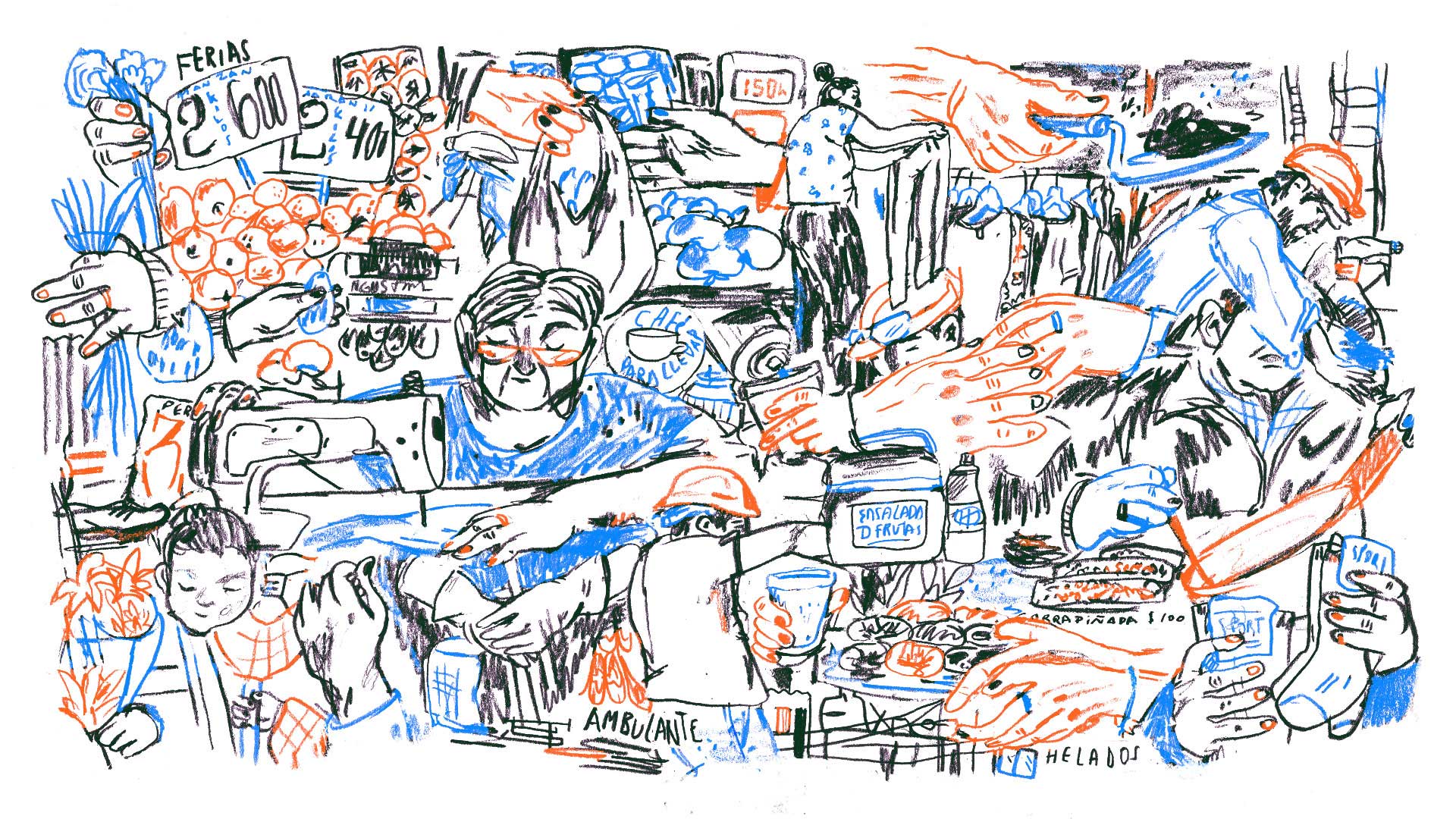The redesign of any employment program requires evidence about the characteristics of the target population. That is, the labour and social activities they perform, their employability profiles and their professional expectations, among others. This paper investigates the universe of the popular economy and the beneficiaries of Potenciar Trabajo. Taking evidence from a qualitative field study carried out in the City of Buenos Aires during 2023, it seeks to debunk some myths about employment programs and identifies which factors are associated with a higher probability of reaching formal employment.
Illustration: Juli Alvarez.
This document presents data from the Popular Economy Survey conducted by Fundar in the Autonomous City of Buenos Aires under an agreement with the Ministry of Human Development and Habitat of the Government of the Autonomous City of Buenos Aires during 2023.
Regarding Potenciar Trabajo
Potenciar Trabajo is part of a long series of employment plans. It was created in 2020 as a labour insertion plan to contribute to improve employability and promote full social inclusion of people in situations of high social and economic vulnerability.
As an important part of social policy in Argentina, Potenciar was structured around conditional cash transfers. Thus, the beneficiaries of the program received the equivalent of half a Minimum, Vital and Mobile Wage. In return, they had to participate in socio-productive and community processes, or they could choose to be trained in trades or to finish their primary and secondary education.
Unlike the other programs, Potenciar Trabajo could not be applied for by individuals, but rather in association with a “Management or Certification Unit”. These executing units organize and certify the completion of the four hours of daily work.
Four myths about employment programmes
Myth 1: "They get paid and do nothing".
The results of this study speak for themselves: 8 out of every 10 people (78%) make employment compensation for receiving the program’s benefits. Of this group, half (37.6%) report that the payment to Potenciar is their main occupation, and the other half (40.4%) indicate that it is a secondary occupation.
The tendency for beneficiaries to be oriented towards a labour consideration is not only observed in the city of Buenos Aires. According to a survey carried out by the National Ministry of Social Development, of the more than 1.2 million registered beneficiaries, 93.7% were in exchange for work, while the remaining 6.2% did so through job training or education.
Myth 2: "They don't have a working culture".
The people targeted by the program attach high importance to fulfilling their work obligations. A total of 93.9% consider it “important” or “very important” to complete their tasks in the stipulated time. This percentage drops to 85% among those who are not beneficiaries of the program.
Myth 3: "They don't want to have a formal job because they prefer to collect a plan".
According to the survey data and the testimonies collected, aspiring to formal employment is a very present ideal among beneficiaries. As we can see in the graph, the main aspiration of the surveyed population (particularly among those who would like to change jobs) is to have access to formal employment, with a peak of 77.4% among those who do not receive the benefits in exchange for work (“Other” category).
This set of preferences, and in particular the valuation of formal employment, can also be seen in the testimonies collected from the interviews. Aspiration is often mentioned in the interviews, alluding to the various benefits of formality, such as the importance of stability, of having social security or access to credit.
Myth 4: "A plan is enough to live on".
Half of the beneficiaries of Potenciar Trabajo (50.8%) have more than one occupation. In other words, the program functions, to a large extent, as an income supplement for people who receive low remuneration for their jobs. Even those who report that the consideration provided by Potenciar Trabajo is their secondary occupation receive low income for their main occupation: more than 60% of them report receiving an income equal to or less than half a minimum wage for their main occupation.
Four recommendations for the design of employment programmes
Employment programs were conceived as transitory, but their persistence over time, the expansion of their coverage over the last decades and the poor results of our country in terms of job creation reinforces the need to rethink them.
Furthermore, the current economic context in Argentina makes it strategic to rethink the relationship between employment programs and formal employment. Because, even if economic growth is a necessary condition for job creation, the social and labour integration policy can and should promote virtuous linkages between the target population of programs and the opportunities to access quality jobs.
Any redesign must include the target population, the activities they carry out, their labour aspirations and the criteria of equity of access and transparency in management. Based on the work carried out, we detail a series of recommendations for redesigning employment programs, in general, and Potenciar Trabajo, in particular. They are also valid for working on policies that integrate the entire universe of the popular economy, in this case in the Autonomous City of Buenos Aires.
Recommendation 1: Clarify the access criteria
As we have seen, Potenciar Trabajo is a program focused on people with low incomes. This means that the people most likely to receive the program are typically vulnerable social groups (such as women, residents of poor neighbourhoods and people with low educational levels). However, the program only reaches a small portion of the target population: only 17.9% of the population of the popular economy is a beneficiary of the program. This means that there is a universe with similar characteristics that could have access but is not covered.
This is explained by the fact that only those who could become beneficiaries could do so through a linkage with a “Management and Certification Unit”. According to the information presented, most of those who work and receive Potenciar Trabajo as consideration for their main occupation are engaged in activities through a cooperative or socio-community association.
As long as access to the program depends on belonging to a “Management and Certification Unit”, potential beneficiaries whose profile matches the profile the program wishes to serve will continue to be excluded. Therefore, the application authority must define the mechanisms explaining program entry and selection criteria. Transparency in terms of access, evaluation and monitoring criteria are essential to promote the legitimacy of any public policy.
Recommendation 2: Focusing on education
Only 2.8% of the beneficiaries report that their consideration is educational (either in formal education or through the completion of work courses). This low incidence of educational consideration is key to thinking about the redefinition of employment programs. Above all, taking into account that, as the analyses presented in this document show, formal education attained is the variable that best predicts the probability of accessing a registered job.

A stronger focus on education could also affect the issue of “moonlighting” that characterizes the program’s beneficiaries. Almost half (49.2%) of the people have more than one job. To help reverse this reality, educational benefits can be strengthened, alleviating over-employment and improving their chances of obtaining a formal job.
Recommendation 3: Encourage partnerships with the private sector
Given that almost 75% of the beneficiaries are employed in the personal services and recovery and recycling sectors (in activities such as cleaning services, cooking, waste collection and cleaning of public spaces, among others), it is essential to address productive integration strategies with a strong focus on sectoral needs. These strategies must contemplate the articulation with local productive networks.
Furthermore, we believe any redesign of programs must integrate the formal labour market, either by enabling compatibility between receiving a plan and having a formal job, or another type of similar scheme, to avoid generating disincentives to formality.
Recommendation 4: Considering the Community fabric
Almost 1 out of every 10 people who are part of Potenciar Trabajo in the Autonomous City of Buenos Aires (9.6% in the previous graph) works in community dining halls and picnic areas. These are central activities for the community fabric of working-class neighbourhoods. However, by their very nature, these are activities that, even if they can be assigned a monetary value, are difficult for the private sector to absorb in the short term. Therefore, any redesign must include the characteristics of these activities.
This link provides access to the repository of data used in this report. The database used comes from the Survey of the Popular Economy of the City of Buenos Aires (2023). The link provides access to the repository where the survey databases, the codebook, the do file to replicate the analyses presented in this report and the questionnaire used in the survey can be found.

